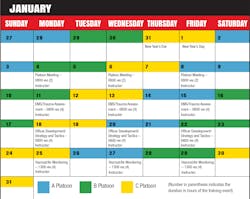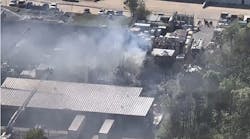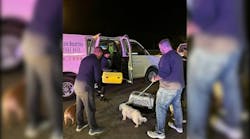Developing a training program for a combination department can be a monumental endeavor. Not only do you have a full-time career staff to train, but you also have a volunteer workforce that must be developed. Although these individuals have varying schedules, work hours and availability, there must be a clear and consistent approach to training. There is no greater frustration for firefighters than not having a plan of attack, both on the fireground and in training. So how do you develop a successful training program that accommodates both career and volunteer members?
Have a plan
The first step is to actually have a written plan in place. This may seem like a huge undertaking, but in reality, it can be put in place in phases. Start with a simple written schedule of training dates and topics. There is nothing worse than showing up for a training event and the instructor asking “so what do you want to train on today?” This typically results in a lackluster training session and eventually a general disgust for training all together.
You can further build on this by having a strong awareness of the national, state and local requirements that you must meet. You can find help in identifying these by asking your fire chief, state fire directors or other individuals who have knowledge of these requirements. After you identify these, it’s just a matter of putting pen to paper (or more likely, fingers to keyboard). Documenting the information allows everyone in the organization to understand the training requirements and realize the importance of it. Each member can see the progression of the training program and, therefore, no one is surprised by what type of training will be held and when.
The format will be different from department to department, but ensure that your training plan has a few basic elements:
- A summary: This should address the importance of training, the scope of the training plan and who is responsible for implementing it.
- Reference standards: Where are you getting your information and what standards are the members expected to meet?
- Calendar: Although exact dates may not always be available, at a minimum divide training up by months. This is key. If you don’t make timelines for yourself, it is easy to let things slip by.
Be consistent, yet flexible
It is important to note that whether a career or volunteer member, everyone is expected to perform the same functions at the same level of proficiency. Therefore, the training program must be tailored to be consistent across the board for all members. This means that everyone is accountable to the same performance standard. This can definitely be a challenge for certain departments, as most volunteers often do not have as much time available to take classes and become certified. In addition, members often have varying degrees of skill level and differing abilities, from the newest members to the most seasoned.
This is where minimum performance standards and consistency come into play. At a minimum, we want all members to have the capabilities of a NFPA 1001 Firefighter I and/or II. However, being trained to this level and being certified to this level are two different things. Not all departments or members have the time and/or money to certify all career and volunteer members to this level, but that doesn’t mean they can’t train to this standard. For example, you can develop a “Firefighter Task Book” that is modeled from the NFPA standard. This allows for a series of training events and evolutions that the member can work toward. But what about members who complete this task book or other members who are already certified to the standard?
This is where flexibility comes in. Every department has specific needs that vary among jurisdictions. Therefore, your training program needs to be tailored based on the specific needs of your area. There is not much need to train all members to ARFF Technician Level if you don’t have an airport in your area. The argument could be made that it is always possible to have a downed aircraft, which is true, but it’s not a high-probability event so it’s not a high-priority training task. Focus in on what is essential and required for your department. For example, a written list of services that your department provides should be developed. After this, determine which skills are needed to accomplish these services. These skills will serve as the basis for your training program. This is the reason that you cannot just copy and paste a training plan from someone else. You must customize it for your department.
How do you get it right?
So how do you make it work? How do you know you are building the system properly? The answer is you won’t initially. No two departments are the same. Therefore, even if you model your program off of another successful program, there is no guarantee that it will have the same results.
You must gather feedback from the membership. That’s right, ask the people who train every day. They are in the best position to tell you what needs to be tweaked and what can make the training program more successful. It’s important to note that as the training officer, you must be able to decipher this feedback and realize that you will never make every person happy. Not everyone’s schedule is going to be accommodated by the training program. However, the minimum performance standards must hold true for all members. Also, have strong awareness of the national, state and local requirements when it comes to training. Make sure your training program is meeting as many of these requirements as possible.
Don’t be afraid to make changes. Odds are you won’t get it 100 percent right the first time, and it’s best to realize that from the beginning. So don’t keep doing something that doesn’t work. If it needs to be changed, be humble enough to change it. The changes can be small, such as changing the training date or time to be more accommodating. Or the changes can be more drastic, such as going from a scheduled training day to a ride-out training program.
For example, my department once had weekly volunteer training sessions without any written schedule. After determining this wasn’t working, a written weekly training schedule was published that included specific topics and incorporated classroom and practical skills sessions. Six months later, it was determined that this was not being effective and another change was in order. This time the volunteer members were required to perform a minimum number of hours of ride-outs with the on-duty staff during which time they performed a set number of training hours. This allowed flexibility for the volunteers as well as developed a tight-knit, highly cohesive firefighting force between career and volunteer members. Now, the members train with various shifts and crews and they all learn from each other. This system is currently working well, but I’m sure adjustments will be made in the future.
So ask yourself these questions: Is the training program beneficial? Is it effective and efficient? Is it working? If the answer is no, then make a change.
In sum
A written, comprehensive training plan will allow any department to make their entire training program more effective and efficient. Without a plan, chaos ensues. This is often the biggest stumbling block for departments. When you actually have something in writing, it is so much easier to adjust later. The plan doesn’t have to be elaborate or fancy, but it does need to be consistent and hold every member to the same performance standard. Furthermore, it has to be flexible enough to allow for changes and/or revisions as needed. These changes can only come by seeking feedback from the members and taking an honest look at whether the training program is truly meeting the needs of the personnel. Fire departments are responsible for a wide array of different services above and beyond fire suppression. Therefore, a training program must be designed to address each of the potential situations that a firefighter may be required to respond to or mitigate. A successful training program is achievable; you just have to get started. Train, train and then train some more!
Sidebar: Sample Training Program for Combination Departments
The [fire department name here] is an all-hazards response organization, responding to any call for service from the community or neighboring jurisdictions. This unique responsibility requires dedication and planning from all members of the department. Part of this planning includes increasing and maintaining the operational capabilities of members. The knowledge, skills and abilities of our members are critical to the successful outcomes during these all-hazards responses. By developing a training program, we can focus our efforts on successfully fulfilling our roles as emergency responders.
The Training Program will ensure that all personnel are receiving the appropriate amount and type of training. The topics and amount of training will be based on multiple factors. These include local community needs, state, local and federal requirements, ISO recommendations, deficiencies noted during emergency incidents or training evolutions, self-development, industry-wide best practices and any other topics deemed necessary.
All volunteer members will be required to perform at least 12 hours of training ride-outs with the on-duty career staff. This training time shall be done in a minimum of 3-hour increments with a maximum of 12 hours, and must be completed between the hours of 0700 and 2200 hrs. Training ride-outs must be scheduled no later than the 25th of the preceding month. Company officers are responsible for ensuring that no more than three volunteer members are scheduled to ride-out at any given time. During these ride-outs, members are expected to perform up to their level of certification and completion of their task books. This requirement will allow volunteer members to become intimately familiar with all equipment housed on the apparatus and will allow better familiarity with the operations of the department. The ride-out program should serve to enhance the efficiency and effectiveness of both the career and volunteer staff members, supporting our continuing efforts to develop a true “cohesive firefighting team.” In addition to the ride-out program above, all volunteer members are encouraged to participate in any available training exercise that is offered to the career staff. These training opportunities are outlined in the attached chart.
Due to the complex nature of this training program, a skills task book will be issued to each volunteer member. Each member will be required to bring this task book to training with them in order to keep it up to date. The task book contains a list of skills that must be performed to demonstrate proficiency. The lead instructor will sign these task books verifying the proficiency of each member. A comprehensive skill evaluation will be included that must be completed on a semi-annual basis in order to remain on active status. The skill evaluation may be part of a multi-company operation drill in which several components are being evaluated.
The leadership within the fire department realizes the time constraints this may cause to some of our members. However, industry-wide requirements and standards must be met. With that being said, we have made a commitment to make a successful training program and ensure that it is flexible enough to accommodate all members, so as not to cause an undue burden on them.
In an effort to provide advanced notice to members and instructors, a calendar of events has been created that details scheduled training events for the career staff. The schedule will include one day each week of department-led training. The remaining days will be reserved for company-led training, such as minimum company standards, district orientation, preplanning, etc. As noted, all volunteers are encouraged to participate as often as possible, while meeting the minimum training hour requirements. It should also be noted that this is a dynamic training program and can be adjusted as necessary.






